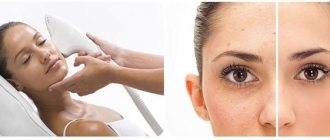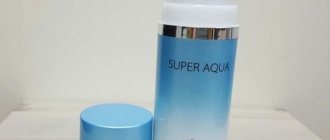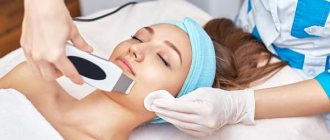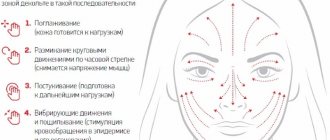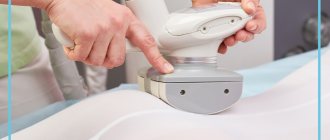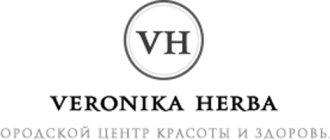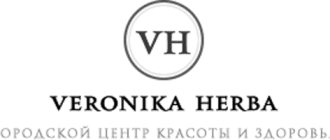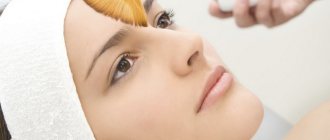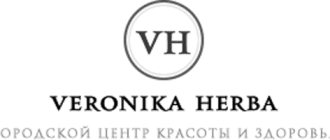Every woman wants to have a radiant and fresh look, so thousands of products, procedures and other tricks are used. The face needs constant hydration, nutrition and cleansing. If the first and second can be achieved with the help of a good cream, then the last one is worth dwelling on in more detail.
To effectively cleanse the skin, it is necessary to use a peeling, or exfoliant, for the face. Why clean the skin mechanically if our body has a renewal process at the cellular level?
Our epidermis consists of five layers of cells: the youngest are inside, and the oldest, dead ones are on the outside. This top layer retains moisture in the skin. Under the influence of negative factors, the outer layer may thicken. The layering of dead cells prevents the skin from functioning properly and causes keratosis (the skin becomes rough and dense).
To prevent this condition, special cleaning compounds are used. They perform facial skin exfoliation, which literally translates from English as “exfoliation.”
Why exfoliation is so important for beautiful skin
Our skin is constantly regenerating, and within 4 weeks a new cell makes its way to the top layer of skin.
All these days in the cycle, the upper keratinized scales fall off on their own. This is a natural exfoliation process. If it were always like this, we would look better, but, alas, starting from the age of 14, although we do not notice it, and until the age of 23, the exfoliation process proceeds at an increasingly sluggish pace. Horny scales do not fall off in even layers and do not immediately create roughness. Moreover, the horny scales often detach from one or more parts. Imagine a fish whose scales stick out in different directions. No specularity or shine. So it is with us. Instead of shine and bright colors, dullness is visible, the skin takes on an unhealthy shade. Children do not need exfoliation; it goes well for them as is. But in adults it goes away with problems. Therefore, helping the scales fall off and doing it so that the remaining layer is even is the main task of proper exfoliation.
Types of beauty products
According to their intended use, the funds are divided into those intended for:
- faces;
- bodies.
Based on the principle of action, exfoliants are divided into:
- chemical - acid “solos” as the main substance for exfoliation;
- mechanical – with inclusions of abrasive particles of different sizes and structures;
- combined - contain both acids and rough exfoliating particles.
Possible release form:
- cleansing gel;
- foam for washing;
- mask;
- soap;
- scrub;
- cream;
- gommage
What is “correct” exfoliation?
Most peels usually deal with the epidermis and are the process of removing old, dead skin cells from the top layer of skin. This is called superficial peeling. We will not talk about medium and deep peelings in this article; they are done under the supervision of cosmetologists. So, what is correct peeling: If after our exfoliation the horny scales are removed and the remaining layer is smooth and undamaged, then this is correct exfoliation. If you think that any peeling or scrub gives such an effect, then you are mistaken, but this will be discussed below.
Enzyme peeling Papaya Enzyme Peel.
Suitable for any skin type, including very sensitive skin with rosacea. New client? Is it difficult to predict your skin's reaction? Choose enzyme peeling and you won’t go wrong.
Peeling should be applied in a layer of medium thickness using a brush. Then cover with film (enzyme peeling really likes a moist, warm environment). Used for face, neck and décolleté. Exposure time is from 5 to 10 minutes. The extent of its duration depends on the type of skin - the oilier, the longer. Wash off with warm water.
It is all-season and can be recommended for home care. Perfectly cleanses the skin of excess sebum and impurities, reduces the appearance of pigmentation, and has an anti-inflammatory effect.
How often should you exfoliate?
Let's start with the fact that based on circadian rhythms, our skin carries out independent exfoliation every evening from 20 to 22 hours. Our task is to help her with this, or at least not to interfere. How to help?
- Remove makeup, cleanse your face of dirt and waste products during the day.
- Use facial cleansers with exfoliating ingredients. Their percentage is very small, so this is not a full-fledged peeling, but helps to fall off those scales that are practically hanging by a thread.
If you don’t do this, your appearance will require peeling more often than once a week, and this is not correct, as we will discuss below. If your evening cleansers help exfoliate, i.e. contain special ingredients for exfoliation, then in most cases peeling once a week is enough. There are exceptions. When you're over 30, daily exfoliation may not be enough and you'll need a deeper exfoliation at the salon.* *Deep and medium peels do more than simply remove the stratum corneum.
What's the benefit?
As you know, skin has several layers. The topmost layer, the stratum corneum, consists of dead cells and performs a protective function. Gradually, these cells peel off and are replaced by new ones. It is the speed of this process that determines how fresh the complexion, clean and smooth skin will be. Exfoliation is used to stimulate it.
The procedure can significantly reduce the severity of acne and post-acne, prevent the appearance of comedones and stop their development, solve the problem of dullness and flaking of the skin, minimize the effects of hyperkeratosis, and have a pronounced rejuvenating and brightening effect.
Methods of exfoliation
Acid peels
Acids are a group of cellular turnover accelerators.
The principle of action of acid peels is simple: They weaken the “glue” that holds skin cells together, and the cell falls off on its own. Of all the AHA acids (glycolic, lactic, malic, etc.) used in peels, lactic acid is the safest. Lactic acid
has a larger molecular chain structure, which allows for gentler penetration and safer results. In addition, lactic acid has better lightening properties as well as excellent hydrating effects. Right away it is both gentle and effective.
Glycolic acid
is another AHA acid and is more widely used in chemical peels.
Glycolic acid has a shorter molecular chain structure, so it irritates the skin more easily. On the other hand, it does a better job of “loosening the glue” that binds skin cells together. Therefore, Glycolic Acid does a better job of exfoliating, resulting in a smoother, brighter, and clearer complexion. Beta hydroxy acids
or BHAs work in the same way as AHAs, they loosen the “glue”. The most famous BHA is salicylic acid, which is found in willow bark. The benefit of salicylic acid is that it has the ability to penetrate fats and lipids, making it great for degreasing clogs. Therefore, peelings with are recommended for exfoliation for people with oily skin. salicylic acid.
Peeling with lactic acid Lactica Exfoliate 10%.
In addition to the main task (cleansing), peeling with lactic acid perfectly moisturizes and brightens the skin. Suitable for all skin types except very sensitive. There is no absolute contraindication in her case, but you need to work with great caution.
Peeling is applied in a thin layer according to the following scheme: forehead, cheeks, chin, wings of the nose, nose, neck. That is, from less sensitive areas to more. Exposure time is 2-10 minutes (average 5 minutes). All this time, the cosmetologist must stand over the client and carefully monitor the skin reaction. If it begins to turn red, turn white, or the client feels a strong burning sensation, the peeling should be immediately removed with pH neutralizing gel Balance Gel. If everything is in order, upon completion of the procedure, the peeling is washed off with regular cool water.
The use of a restorative mask after milk peeling is mandatory. The product is not suitable for home care.
Scrubs and gomazhi, mechanical exfoliation
Scrubs are considered “mechanical” exfoliation.
The principle of a scrub is simple, it contains mechanical abrasives in a cream or solution designed to “wipe away” dead skin cells through manual manipulation. And here is the most important thing. Scrubs can be dangerous, depending on what's inside them. For example, if the injected rough particle is uneven and jagged, it can cause micro-tears in the skin, which can cause damage to your complexion over time. Rub lacquered furniture with salt or sugar and the results will not be long in coming. Scratches and damage will not give the skin shine and even color. Even by removing some particles of the stratum corneum, you will damage the other layer and the result will not be long in coming. Your skin will lose its shine and color much faster. It is no coincidence that some girls increase the frequency of scrubbing to 2-3 times a week. Why then do they scrub their faces with such scrubs?
, you ask, if there is no result? There is a result, but not the same. Firstly, like any scrub, it removes some of the particles that are ready to fall off. Secondly, when rubbing the skin with sharp particles, a certain aggressive “massage” occurs, the blood comes to the face and it really looks better for a while, thereby hiding the damage caused by the scrub. It is these improvements that the result of scrubbing is perceived to be. But the next day or the day after, the situation worsens and the shortcomings are visible to the naked eye.
The scrub should contain only soft, non-sharp particles
. The task of the scrub is to mechanically press on the scales, causing the “glue” holding them together to stop working. The scrub does not “tear off” the particles, but kneads the “glue”
Exfoliant composition
The active substances in exfoliants are AHA and BHA, alpha and beta hydroacids, respectively. The names seem complicated, but in fact we are talking about drugs that have long been used and popular in cosmetology.
- AHAs are water-soluble acids. The most famous among them are glycolic and milk. In addition, apple, lemon, and wine are used.
- BHA is a well-known salicylic acid. This component is not water-soluble, but it penetrates well through fat barriers into the deeper layers.
For cleansing, both individual acids and their combinations can be used, taking into account the type and condition of the skin and the desired result. The concentration of reagents plays an important role in this process. So, an exfoliant can be one of the components of the product, listed on its packaging as “peeling”, and used for chemical or combined facial cleansing.
Mechanism of action
The result of using an exfoliant cream depends on the ingredients it contains. The components of the product are absorbed into the skin, dissolving and eliminating keratinized, excess particles. At the same time, the natural processes of creating new cells are accelerated. Cosmetologists borrowed this idea from dermatologists. After all, it is on this principle that medicinal drugs that fight skin pathologies work.
When dead particles are removed from the surface of the skin, its cells begin to quickly renew themselves, replacing the vacant space with elastic tissues. At the same time, even minor scars and wrinkles disappear, and the skin itself acquires a beautiful glow. The exfoliant cream has a rejuvenating effect, which is clearly visible even after the first use.
Such products should be used with extreme caution. After all, aggressive chemical composition can damage the skin in inept hands. If you use such a cream, following the instructions exactly, you can get amazing results.
Feedback on the most popular creams
If possible, read reviews about the brand you like. Experts advise choosing products from popular brands with a good reputation. For example, reviews of the exfoliant cream “Bark” with fruit acids are overwhelmingly positive. Girls who have used this product note its high effectiveness and safety. According to them, the exfoliant cream “Cora” perfectly cleanses the skin, eliminates minor imperfections and tones it. Even after one application, the effect becomes visible: clean, smooth skin, radiant with health. It perfectly revives problematic skin, lightens age spots, eliminates small scars and post-acne - that’s what the “Bark” cream mask is capable of. The exfoliant of this brand is popular and has rave reviews, so you can safely buy it without any worries. Just be sure to choose a product that suits your skin type.
“Belita Vitex” is another equally popular cream mask with fruit acids. Reviews about the exfoliant of this brand are also mostly positive. The product from the Belarusian manufacturer gives excellent results after the first use. The skin acquires an even tone, healthy appearance and shine. Girls who have used this product note a pleasant feeling of freshness and lightness after the procedure. According to reviews, the exfoliant cream “Belita Vitex” is absolutely safe when used correctly and gives excellent results.
Tips for choosing
In order to stock up on a truly effective product, you should learn to understand its chemical composition. Thus, the concentration of active ingredients in the exfoliant plays a very important role. Alpha acids in the composition of the product should be about 5-10%, and beta acids - a maximum of 2%. It is very important to pay attention to this nuance and choose the right cream. If there are too few acids, then you simply will not see any effect, but if their concentration exceeds the permissible level, then you risk severely damaging the skin. Believe me, to return the dermis to its former state you will have to make titanic efforts.
Secrets of successful application
When choosing this care product, consider the characteristics of your skin type and care for it.
- Not every epidermis tolerates the effects of AHA and BHA acids well. They cause irritation and increase sensitivity. If you have sensitive skin prone to redness and allergies, an exfoliant with a high concentration of acids will most likely not be suitable for you.
- For oily skin, exfoliate in the morning. Dry and normal before bed.
- Dry epidermis is exfoliated no more than once every 2 weeks.
- For skin prone to rashes, use gels and creams with BHA acids.
- Night creams with alpha hydroxy acids are suitable for fading, aging epidermis.
- The more delicate your skin, the softer the product should be. Be careful with compounds containing large abrasive particles. They may scratch your face. The best option for sensitive types is gommage.
- If you use a treatment containing retinoids, carry out the exfoliation procedure in a course (for example, every 3 months for 2 weeks). During this time, avoid products with retinoids to avoid burns.
- Be sure to wait until the product is completely absorbed if you use it in the morning. And only then apply makeup. The pores will have time to close, particles of cosmetics will not get into them and will not contaminate the epidermis.
- Regardless of how active the sun is, use creams with a UV barrier when using exfoliants. In winter, the SPF factor may be slightly lower than in summer.
- Products with a high concentration of AHA acid can only be used when the weather is cloudy and cool outside.
- Aggressive chemical exfoliants are used in a course, according to the scheme indicated on the label.
